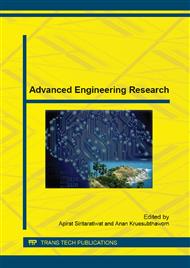[1]
M.A. Roa, R. Suárez, Grasp quality measures: review and performance, Auton. Robots. (2014) 1–24.
Google Scholar
[2]
C. Ferrari, J. Canny, Planning optimal grasps, in: 1992 IEEE Int. Conf. Robot. Autom. 1992 Proc., 1992: p.2290–2295 vol. 3.
Google Scholar
[3]
J. Ponce, S. Sullivan, A. Sudsang, J. Boissonnat, J. -P. Merlet, On Computing Four-Finger Equilibrium and Force-Closure Grasps of Polyhedral Objects, Int. J. Robot. Res. 16 (1996) 11–35.
DOI: 10.1177/027836499701600102
Google Scholar
[4]
A. Dandurand, The Rigidity of Compound Spatial Grids, (1984).
Google Scholar
[5]
N. Niparnan, A. Sudsang, Fast computation of 4-fingered force-closure grasps from surface points, in: 2004 IEEERSJ Int. Conf. Intell. Robots Syst. 2004 IROS 2004 Proc., 2004: p.3692–3697 vol. 4.
DOI: 10.1109/iros.2004.1389989
Google Scholar
[6]
N. Niparnan, T. Phoka, A. Sudsang, Computing Frictionless Force-Closure Grasps of 2D Objects from Contact Point Set, in: IEEE Int. Conf. Robot. Biomim. 2006 ROBIO 06, 2006: p.872–877.
DOI: 10.1109/robio.2006.340335
Google Scholar
[7]
N. Niparnan, A. Sudsang, Positive Span of Force and Torque Components of Four-Fingered Three-Dimensional Force-Closure Grasps, in: 2007 IEEE Int. Conf. Robot. Autom., 2007: p.4701–4706.
DOI: 10.1109/robot.2007.364203
Google Scholar
[8]
Y. Zheng, C. -M. Chew, Distance Between a Point and a Convex Cone in n-Dimensional Space: Computation and Applications, IEEE Trans. Robot. 25 (2009) 1397–1412.
DOI: 10.1109/tro.2009.2033333
Google Scholar
[9]
C. Borst, M. Fischer, G. Hirzinger, Grasping the dice by dicing the grasp, in 2003 IEEE/RSJ Int. Conf. Intell. Robots Syst, 2003. (IROS 2003). Proc., 2003: p.3692–3697 vol. 3.
DOI: 10.1109/iros.2003.1249729
Google Scholar
[10]
A. Kasper, Z. Xue, R. Dillmann, The KIT object models database: An object model database for object recognition, localization and manipulation in service robotics, Int. J. Robot. Res. (2012).
DOI: 10.1177/0278364912445831
Google Scholar


